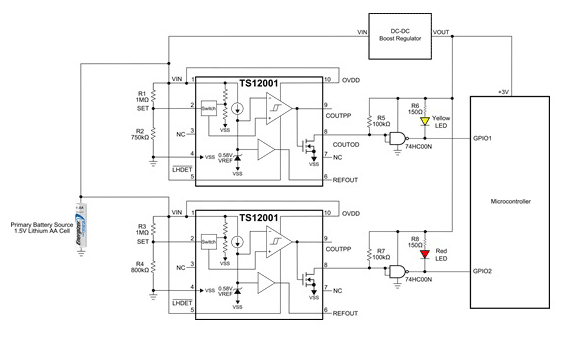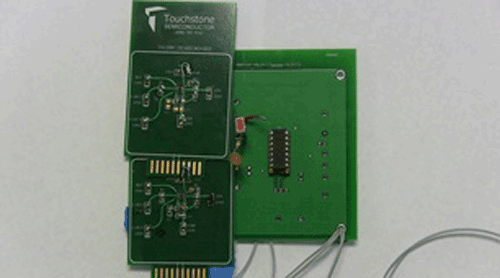Touchstone Semiconductor, Inc.
Low battery detection is important in battery-powered systems to alert the user to replace the battery. In some cases, a secondary level of detection is necessary to alert the system to a critical low battery level. A nanopower voltage detector device can be implemented that combines a low-power reference and a comparator to build a simple low battery detection circuit.
Measurement set-up
As shown in Figure 1, a low-battery detection application circuit can be designed using two low-power voltage detectors, such as the Touchstone TS12001. The detectors are powered by a single 1.5V lithium AA battery whereas the other parts of the circuit are powered from 3V supplied by a separate boost converter. A threshold voltage of 1.356V and 1.288V is set for the top voltage detector IC and the bottom voltage detector IC, respectively. When the battery drops below a programmed threshold voltage, the detectors’ open drain outputs switch from a LOW state to a HIGH state. Detector output voltages are then applied to NAND gates that generate a LOW state to forward bias the LEDs. The NAND gate outputs are also connected to GPIO inputs of a microcontroller. When the yellow LED detector is triggered, a low battery level (1.356V) is indicated. When the red LED detector is triggered, a critical low battery level (1.288V) is indicated.

Figure 1. TS12001 Low Battery Detection Circuit
For testing purposes, the 1.5V lithium AA battery was replaced with a power supply. Figure 2 shows the complete circuit where two demo boards are used.
Results
When the power supply voltage applied to the SET pin reached approximately 1.356V, the yellow LED turned on and the red LED remained off, representing a low battery level condition. However, when the power supply voltage was reduced further and reached approximately 1.288V, the red LED turned on indicating a critical low battery level. At this point, both LEDs were on as expected.

Figure 2. TS12001 Low Battery Detection Circuit Picture
Other considerations
Some voltage detectors, like the TS12001, make available a comparator latch function. In this IC, the (“LHDET” ) ̅ pin is useful for capturing one-time events. While this function was not explicitly used in this application, the (“LHDET” ) ̅ pin was connected to VIN thereby disabling one-time-latch operation. For detailed explanation of this function, please refer to the video referenced below.The open drain output is useful for voltage level translation. In this circuit, it was used to translate a 1.5V supply to the 3V supply environment required by the downstream microcontroller.
In summary, the application circuit described herein achieves a number of goals: a) user-programmable threshold voltages; b) low-supply-voltage operation from 0.65V to 2V; c) low-monitor-mode supply current of 2µA; and d) small active pcb area less than 5mm2, including external components if the discrete NAND gates are already part of a system gate array.
For additional information, please follow the links to the corresponding product pages:
• TS12001 Voltage Detector http://touchstonesemi.com/products/ts12001
• TS12001 Application Video http://touchstonesemi.com/videos/ts12001-application-video
Advertisement
Learn more about Touchstone Semiconductor





